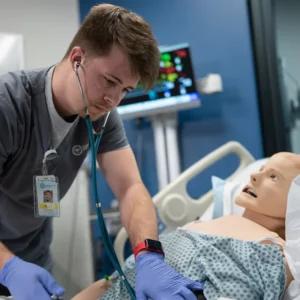 A new study published in the journal Neurology found that people who are diagnosed with depression are at an increased risk of contracting Parkinson’s disease.1 A progressive disorder that affects the body’s nervous system, Parkinson’s is characterized by a gradual worsening of a person’s movement.2 For medical professionals and medical assistants who encounter patients dealing with depression frequently, it is important to be aware of factors that could lead to developing the debilitating disease. Depression comes first Researchers at Umeå University in Sweden found that people with depression were 50 percent more likely than those without it to have Parkinson’s later in life.1 As a result, depression is being considered as an early symptom or risk factor for Parkinson’s disease. Starting in 2005 and studying the entire Swedish population who were over 50 years old, researchers used medical records spanning from 1987-2012 and discovered that over 140,000 people were suffering from depression.1 Due to the country’s large database on the health of its population, researchers could then determine how many had developed Parkinson’s disease. Scientists also found that the severity of depression correlated with a higher likelihood of the onset of Parkinson’s. Researchers discovered those hospitalized once for depression were 3.5 times more likely to develop Parkinson’s as opposed to the 40 percent chance for those who were hospitalized four or five times.1 The distinction between a cause and a risk factor Although these results are extremely beneficial for Parkinson’s research, James Beck, vice president of the Parkinson’s Disease Foundation, said the results don’t necessarily point to depression being a direct cause of Parkinson’s.3 The causes for the disease are still unknown, but it appears that things like genetics and exposure to environmental factors or toxins play a role of some kind. Instead, depression is considered a risk factor, among others like age, heredity and a person’s sex.2 Beck stresses the importance of early testing if someone dealing with depression starts to notice warning signs or symptoms common to Parkinson’s, including tremors, problems with movement and rigid muscles.3 Due to the fact that there is no known cause of Parkinson’s disease, there is also no cure. However, there are different treatment options available depending on the severity of a person’s symptoms. Some can be lessened by lifestyle changes and physical therapy that focuses on stretching and balance to help with tense muscles.4 Others can be helped by a variety of different medications that can help increase the brain’s levels of dopamine. For those with advanced levels of Parkinson’s and an unstable response to medications, surgical treatments, like deep brain stimulation can help reduce the symptoms.4 Umeå University scientists, as well as those at the Parkinson’s Disease Foundation, agree that additional research into Parkinson’s disease is necessary to shed additional light on the crippling disorder. For medical assistants and other health care professionals, the ties between depression and Parkinson’s offer a helpful clue into the origin of the disease. 1“Depression linked with development of Parkinson’s disease” Stephen Feller, United Press International, May 21, 2015. http://www.upi.com/Health_News/2015/05/21/Depression-linked-with-development-of-Parkinsons-disease/8211432218643/. 2“What is Parkinson’s Disease?” Parkinson’s Disease Foundation, 2015. http://www.pdf.org/en/about_pd. 3“Depression Raises Parkinson’s Risk, Study Confirms” Maggie Fox, NBC News, May 21, 2015. http://www.nbcnews.com/health/health-news/depression-raises-parkinsons-risk-study-confirms-n362091. 4“Parkinson’s Disease: Treatment and drugs” Mayo Clinic, May 28, 2014. http://www.mayoclinic.org/diseases-conditions/parkinsons-disease/basics/treatment/con-20028488.
A new study published in the journal Neurology found that people who are diagnosed with depression are at an increased risk of contracting Parkinson’s disease.1 A progressive disorder that affects the body’s nervous system, Parkinson’s is characterized by a gradual worsening of a person’s movement.2 For medical professionals and medical assistants who encounter patients dealing with depression frequently, it is important to be aware of factors that could lead to developing the debilitating disease. Depression comes first Researchers at Umeå University in Sweden found that people with depression were 50 percent more likely than those without it to have Parkinson’s later in life.1 As a result, depression is being considered as an early symptom or risk factor for Parkinson’s disease. Starting in 2005 and studying the entire Swedish population who were over 50 years old, researchers used medical records spanning from 1987-2012 and discovered that over 140,000 people were suffering from depression.1 Due to the country’s large database on the health of its population, researchers could then determine how many had developed Parkinson’s disease. Scientists also found that the severity of depression correlated with a higher likelihood of the onset of Parkinson’s. Researchers discovered those hospitalized once for depression were 3.5 times more likely to develop Parkinson’s as opposed to the 40 percent chance for those who were hospitalized four or five times.1 The distinction between a cause and a risk factor Although these results are extremely beneficial for Parkinson’s research, James Beck, vice president of the Parkinson’s Disease Foundation, said the results don’t necessarily point to depression being a direct cause of Parkinson’s.3 The causes for the disease are still unknown, but it appears that things like genetics and exposure to environmental factors or toxins play a role of some kind. Instead, depression is considered a risk factor, among others like age, heredity and a person’s sex.2 Beck stresses the importance of early testing if someone dealing with depression starts to notice warning signs or symptoms common to Parkinson’s, including tremors, problems with movement and rigid muscles.3 Due to the fact that there is no known cause of Parkinson’s disease, there is also no cure. However, there are different treatment options available depending on the severity of a person’s symptoms. Some can be lessened by lifestyle changes and physical therapy that focuses on stretching and balance to help with tense muscles.4 Others can be helped by a variety of different medications that can help increase the brain’s levels of dopamine. For those with advanced levels of Parkinson’s and an unstable response to medications, surgical treatments, like deep brain stimulation can help reduce the symptoms.4 Umeå University scientists, as well as those at the Parkinson’s Disease Foundation, agree that additional research into Parkinson’s disease is necessary to shed additional light on the crippling disorder. For medical assistants and other health care professionals, the ties between depression and Parkinson’s offer a helpful clue into the origin of the disease. 1“Depression linked with development of Parkinson’s disease” Stephen Feller, United Press International, May 21, 2015. http://www.upi.com/Health_News/2015/05/21/Depression-linked-with-development-of-Parkinsons-disease/8211432218643/. 2“What is Parkinson’s Disease?” Parkinson’s Disease Foundation, 2015. http://www.pdf.org/en/about_pd. 3“Depression Raises Parkinson’s Risk, Study Confirms” Maggie Fox, NBC News, May 21, 2015. http://www.nbcnews.com/health/health-news/depression-raises-parkinsons-risk-study-confirms-n362091. 4“Parkinson’s Disease: Treatment and drugs” Mayo Clinic, May 28, 2014. http://www.mayoclinic.org/diseases-conditions/parkinsons-disease/basics/treatment/con-20028488.



